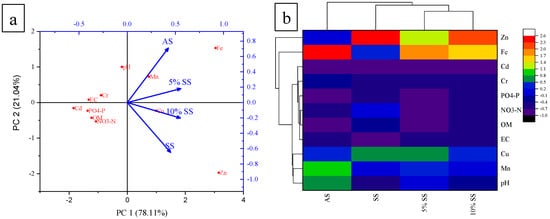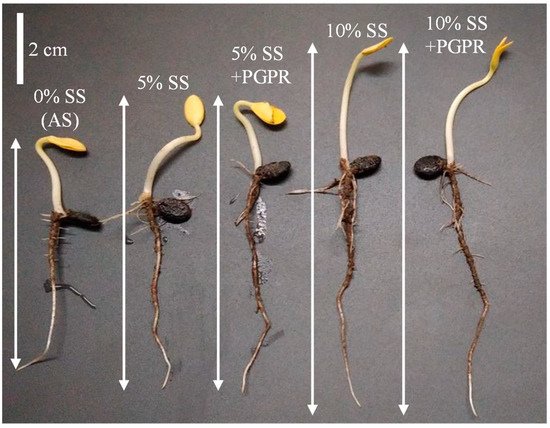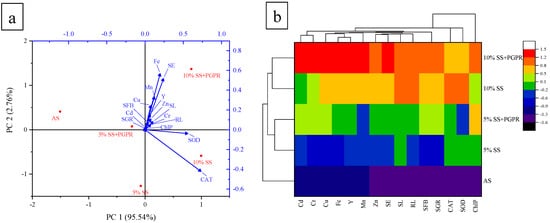Ridge gourd (Luffa acutangula (L.) Roxb.) or Luffa is a multi-harvest vegetable crop grown in the South Asian region. It is commonly called “Torai” in rural areas of India.
1. Introduction
The rate of domestic waste discharges has recently grown dramatically as a result of an uncontrolled increase in the human population
[1]. Sewage wastewater is amongst the top contributor of domestic wastes, which has become a difficult to manage problem globally
[2]. It is estimated that nearly 359 billion cubic meters of wastewater are generated globally, with only 52% being sufficiently or partially treated while the remaining is disposed of without any treatment
[3]. Sewage sludge (SS) is a solid or semi-solid substance generated from the different steps of sewage treatment plants (STPs). SS could create several environmental issues if not properly disposed of
[4][5][4,5]. Generally, the management of SS occurs at different stages such as production (minimization), collection, treatment, and reuse
[6]. Being rich in various organic and nutrient substances, SS is widely utilized for secondary purposes such as biogas, biochar, syngas, biofertilizer production, composting, building materials, among many others
[7][8][7,8].
During the recent decades, the increasing use of SS in agriculture has appeared as one of the most effective methods of its management due to the presence of abundant nutrients
[9]. Predominantly, nitrogen, phosphorus, potassium, and other microelements are the major constituents of SS that are useful for soil amendment
[10]. Markowicz et al.
[11] reported that SS mixing up to 15 t/ha was the most efficient composition for the reclamation of nutrient-deficient soil. SS application on lands helps in the mixing of various organic and inorganic nutrients, which further leads to improved crop yields
[12][13][12,13]. However, the excessive mixing of SS, having a high nutrient load, may also damage soil health; thereby, affecting plant growth and reducing crop yields
[14]. Moreover, the nutrients may contain metal elements that have relatively high density, which has been regarded as one of the major problems regarding SS utilization due to their toxicity at higher levels
[15]. Therefore, it is necessary to monitor the migration of such elements from SS-treated soils to plant parts for human health benefits.
Ridge gourd (
Luffa acutangula (L.) Roxb.) or Luffa is a multi-harvest vegetable crop grown in the South Asian region. It is commonly called “
Torai” in rural areas of India. Non-ripened fruits of Ridge gourd having tender dark green color are cooked and eaten due to their high nutritional values
[16]. The ripened fruits of Ridge gourd are widely used for various purposes, such as cleaning sponges and mattresses
[17]. Being a multi-harvest crop, the biggest problem associated with Ridge gourd cultivation is the excessive required quantity of fertilizers, which makes it less profitable for the farmers
[18]. Consequently, the yield and nutritional quality of Ridge gourd start decreasing if the required dose of fertilizers is not supplied timely and adequately
[19]. Also, the repeated use of chemical fertilizers makes the soil unhealthy and harmful for microbial communities
[20]. Therefore, SS application for Ridge gourd cultivation could be a potential technique to minimize chemical fertilizer input and improve soil health.
Plant growth-promoting rhizobia (PGPR) is a group of microorganisms that have distinct capabilities to assist the plant root systems in terms of efficient survival and nutrient deliverability
[21]. Commercial-scale PGPRs commonly known as biofertilizers have shown substantial improvements in plant growth and crop yields, making agriculture more profitable
[22][23][22,23]. A study has found that supplementation of PGPR was helpful for increased nutrient extraction by mustard green (
Brassica juncea). Konkolewska et al. found that supplementation of PGPR was helpful for increased nutrient extraction by mustard green (
Brassica juncea)
[24]. Ke et al. also showed improved nutrient uptake by perennial ryegrass
[25]. Moreover, Ipek et al. reported an increased yield and nutritional profile of strawberries under PGPR treatments
[26]. Considering the role of PGPR in plant-nutrient delivery, it can be potentially used for Ridge gourd cultivation along with SS application for improved nutrient utilization. However, some of the toxic metal elements may also accumulate in edible parts of Ridge gourd, which might not be suitable for human consumption due to health concerns. Hence, biomonitoring of these metal elements needs proper attention, along with their potential health hazard.
2. Impact of Sewage Sludge (SS) on Arable Soil Properties
Table 1 provides the physicochemical, nutrient, and metal elements properties of AS, SS, and different treatment groups of SS such as 5, and 10%. The initial basic properties of AS and SS showed that SS was highly enriched with various organic and inorganic nutrients including metal elements. The pH (8.30 ± 0.05), EC (7.21 ± 0.12 dS/m), OM (23.90 ± 3.14%), NO
3-N (31.07 ± 1.380 g/kg), and PO
4-P (14.22 ± 1.10 g/kg) of SS was significantly (
p < 0.05 higher as compared to AS which had pH of 7.28 ± 0.03 units, EC of 2.10 ± 0.08 dS/m, OM of 1.25 ± 0.03%, NO
3-N of 1.60 ± 0.10 g/kg, and PO
4-P of 1.25 ± 0.06 g/kg, respectively. The soil properties were also significantly (
p < 0.05) changed after the SS mixing in both 5 and 10% treatment groups. Contrarily, the availability of all nutrients in AS was slowly increased with an increase in the SS mixing rate which signifies the usability of SS as an efficient nutrient supplement. PCA results showed that SS dose had a significant effect on increased nutrient availability (
Table 2). The data was statistically transformed on two extracted components namely PC 1 and PC2 having eigenvalues of 3.12 and 0.84, while variances of 78.11 and 21.04%, respectively. The axial length of SS treatment in
Figure 2a indicated the positive influence of the AS nutrient properties. Moreover, the analysis of soil physicochemical properties using the Euclidean distance-based neighboring cluster method revealed that metal elements possess more positive interaction (>0.5) with SS dose as compared to other soil nutrients (<0.5) parameters. The heatmap plot shown in
Figure 2b indicates that Zn and Fe were closely related to each other in terms of their available concentration in the soil (mg/kg). Similarly, Mn showed close relation to Cu, while Cd with Cr. Overall, the amendment of SS on AS was helpful to increase its nutrient profile which can be a useful and low-cost fertilization alternative for Ridge gourd crop cultivation in the selected Indian region. Sewage sludge has been widely accepted for soil fertilization at the global level. Markowicz et al.
[11] reported that a 15 t/ha rate of SS application was helpful to rehabilitate the degraded soils in Silesian Upland, Southern Poland. Marotrao et al.
[27][33] also used SS (15 to 45 t/ha) for enhancing the soil mineral properties under the rice-wheat cultivation system. Another study by Marotrao et al. also used SS (15 to 45 t/ha) for enhancing the soil mineral properties under the rice-wheat cultivation They found that the soil metal elements under higher SS doses did not exceed the safe limits except for Cd. Thus, SS obtained from STP Jagjeetpur was rich in various nutrient parameters and can be recommended for AS fertilization, provided prior analysis of other toxic elements.
Figure 2. (a) PCA biplot and (b) clustered heatmap for the interaction of sewage sludge (SS) on soil nutrient availability.
Table 1. Soil properties (mean ± standard deviation, n = 3) used for Ridge gourd (L. acutangula) cultivation under different sewage sludge and plant growth-promoting rhizobia (PGPR) treatments.
| Parameter |
ParameterArable Soil |
Sewage Sludge |
Treatments |
|
| Treatments |
5% SS |
10% SS |
| pH |
7.28 ± 0.03 |
8.30 ± 0.05 * |
7.35 ± 0.05 * |
7.68 ± 0.02 * |
| EC (dS/m) |
2.10 ± 0.08 |
Table 2. Principal component analysis (PCA) results of interaction between arable soil, sewage sludge, and metal elements content.
| Parameters |
Principal Components |
| PC 1 |
PC 2 |
| Arable Soil |
5% SS |
5% SS + PGPR |
10% SS |
10% SS + PGPR |
| pH |
−0.18 |
1.00 |
| Total crop yield (kg/plant) |
8.1 ± 0.2 |
9.6 ± 0.3 * |
10.6 ± 0.3 * |
12.6 ± 0.1 * |
13.8 ± 0.1 * |
| 7.21 ± 0.12 * |
| Average crop yield per harvest (kg/plant) |
1.6 ± 0.1 | 2.70 ± 0.20 * |
3.16 ± 0.24 * |
| EC |
−1.32 |
0.08 |
1.9 ± 0.1 * |
2.1 ± 0.1 * |
2.5 ± 0.1 * |
2.8 ± 0.1 * |
OM (%) |
1.25 ± 0.03 |
23.90 ± 3.14 * |
2.18 ± 0.09 * |
2.70 ± 0.10 * |
| OM |
| CV (%) | −1.22 |
−0.42 |
9.5 |
14.3 |
14.9 |
3.8 |
5.1 |
NO |
| 3 |
| -N (g/kg) |
1.60 ± 0.10 |
31.07 ± 1.38 * |
2.06 ± 0.10 * |
| NO | 3 | -N | 3.19 ± 0.15 * |
| −1.07 |
−0.53 |
PO |
| 43− |
| -P (g/kg) |
| PO | 43− | 1.25 ± 0.06 |
-P14.22 ± 1.10 * |
2.10 ± 0.13 * |
3.04 ± 0.09 * |
| −1.36 |
−0.22 |
Root length (cm) |
Cd (mg/kg) |
0.27 ± 0.01 |
2.71 ± 0.23 * |
0.69 ± 0.04 * |
0.94 ± 0.03 * |
| Cd |
−1.84 |
−0.15 |
Cr (mg/kg) |
3.28 ± 0.13 |
11.53 ± 0.46 * |
4.42 ± 0.12 * |
5.25 ± 0.08 * |
| Cr |
−0.90 |
Cu (mg/kg) |
5.46 ± 0.21 |
11.61 ± 0.10 * |
16.33 ± 0.30 * |
| 0.20 |
| Cu |
0.98 | 50.24 ± 2.71 * |
−0.22 |
Fe (mg/kg) |
14.11 ± 1.03 |
39.31 ± 0.99 * |
20.72 ± 0.83 * |
29.01 ± 2.11 * |
| Fe |
3.04 |
1.53 |
Mn (mg/kg) |
8.28 ± 0.51 |
29.01 ± 0.12 * |
10.52 ± 0.48 * |
13.43 ± 0.87 * |
| Mn |
0.74 |
0.72 |
Zn (mg/kg) |
4.15 ± 0.36 |
110.17 ± 10.55 * |
16.44 ± 3.14 * |
39.03 ± 2.03 * |
| Zn |
3.14 |
−1.97 |
| Eigenvalue |
3.12 |
0.84 |
| Variance (%) |
78.11 |
21.04 |
3. Impact of Plant Growth-Promoting Rhizobia (PGPR) PR and SS on Ridge Gourd Seedling Germination
The result depicted in
Table 3 revealed that the germination of Ridge gourd seedlings was significantly (
p < 0.05) affected by SS and PGPR treatments. The increasing order of selected parameters seedlings germination were recorded in an order of T1 < T2 < T3 < T4 < T5. In this, the highest seedling emergence was obtained using 10% SS + PGPR i.e., 92.3 ± 2.1%. Moreover, the highest seedling biomass, growth rate, seedling length, and root length were recorded as 9.6 ± 0.3 g, 1.4 ± 0.1 g/day, 15.5 ± 0.3 cm, and 10.4 ± 0.3 cm, respectively.
Figure 3 shows the effect of SS and PGPR on Ridge gourd seedling morphology. Plumular hook formation is largely associated with soil structure. This hook structure is favorable to seedlings for soil penetration as it protects the fragile apical growth point from injury. In the 10% and 10% SS + PGPR treatments, the soil structure was loosened so the Plumular hook formation was not seen in these treatments. However, it is possible that increased nutrient availability also affected the ethylene phytochrome formation in the Ridge gourd plant which might affect its growth and senescence. A thick hypocotyl might be due to the rapid growth rate of seedlings which differentiated it from other treatments and achieved more growth within a short period. Besides this, the SOD and CAT enzyme activities were maximally induced from 5 to 10% SS treatments i.e., 96.1 ± 5.3 and 85.2 ± 7.2 µg/g, respectively. However, it was slightly reduced while using PGPR in both 5 and 10% SS doses. On the other hand, the total chlorophyll content of Ridge gourd seedlings gradually increased with an increase in SS and PGPR dose. The maximum chlorophyll recorded was 3.2 ± 0.1 mg/g fwt. in 10% SS + PGPR treatment (
Table 3). PCA results provided in
Figure 4a, and
Table 4 showed that the vector length of SS and PGPR treatments were positively correlated with all morphological and biochemical parameters of Ridge gourd. Also, the heatmap and cluster analysis confirmed relatively positive Euclidean distances in higher SS doses.
Figure 3. Effect of sewage sludge (SS) and plant growth-promoting rhizobia (PGPR) amendment on seedling growth of Ridge gourd (L. acutangula).
Figure 4. (a) PCA biplot and (b) clustered heatmap for the interaction of sewage sludge (SS) and plant growth-promoting rhizobia (PGPR) on metal element contents and biochemical response of Ridge gourd (L. acutangula).
Table 3. Effect (mean ± standard deviation, n = 3) of sewage sludge (SS) and plant growth-promoting rhizobia (PGPR) treatment on germination and biochemical response of Ridge gourd (L. acutangula) seedlings (25 °C for 7 days).
| Parameter |
Treatments |
| Arable Soil |
5% SS |
5% SS + PGPR |
10% SS |
10% SS + PGPR |
| Seedling emergence (%) |
70.3 ± 2.8 |
78.4 ± 1.5 * |
81.9 ± 2.3 * |
86.5 ± 3.5 * |
92.3 ± 2.1 * |
| Seedling fresh biomass (g) |
6.7 ± 0.1 |
7.5 ± 0.2 * |
8.6 ± 0.3 * |
9.1 ± 0.2 * |
9.6 ± 0.3 * |
| Seedling growth rate (g/day) |
1.0 ± 0.0 |
1.1 ± 0.0 * |
1.2 ± 0.1 * |
1.3 ± 0.1 * |
1.4 ± 0.1 * |
| Seedling length (cm) |
7.1 ± 0.1 |
11.3 ± 0.1 * |
11.3 ± 0.1 * |
15.1 ± 0.5 * |
15.5 ± 0.3 * |
| 4.6 ± 0.1 |
7.4 ± 0.1 * |
8.2 ± 0.1 * |
10.6 ± 0.3 * |
10.4 ± 0.3 * |
| SOD (µg/g) |
51.2 ± 4.3 |
74.1 ± 3.9 * |
65.9 ± 2.8 * |
96.1 ± 5.3 * |
90.2 ± 6.2 * |
| CAT (µg/g) |
24.3 ± 2.0 |
63.5 ± 7.0 * |
60.0 ± 3.5 * |
85.2 ± 7.2 * |
78.1 ± 5.8 * |
| Total chlorophyll (mg/g) |
2.4 ± 0.1 |
2.9 ± 0.1 * |
3.2 ± 0.20 * |
3.0 ± 0.2 * |
3.2 ± 0.1 * |
Table 4. Crop yield (mean ± standard deviation, n = 3) of Ridge gourd (L. acutangula) cultivation under different sewage sludge (SS) and plant growth-promoting rhizobia (PGPR) treatments.
It is evidenced that increased bio-availability of nutrients helps in the rapid germination of plants
[28][34]. Seedlings rapidly respond to the easy nutrient availability and texture of soil
[29][35]. In this experiment, the applied SS helped in altering the soil properties which might be beneficial for the Ridge gourd seedlings in terms of rapid adaptation and quicker growth. Similarly, PGPR supplementation assists in survival under stressed conditions such as excess nutrients, heat, cold, drought, pest, and pathogen attacks
[30][36]. The increased nutrient availability as a result of SS mixing also affected the biochemical response of Ridge gourd seedlings which was evidenced from the SOD and CAT enzyme activities. However, PGPR supplementation in those treatments aided in minimizing the SOD and CAT activities which might be due to amelioration of nutrient stress within the rhizosphere zone of Ridge gourd. SOD acts as a defense border for oxidative stress in plants caused by both physical and chemical factors while CAT acts as an important biomolecule that plays important roles in H
2O
2 scavenging, fatty acid oxidation, plant defense, aging, cellular deterioration, etc.
[31][37]. The levels of SOD and CAT might increase under higher nutrient availability; however, their impacts can be minimized if beneficial microbes such as PGPR, vascular arbuscular mycorrhizae, etc. are inoculated within the rhizosphere region which creates secondary pathways for nutrient delivery through microbial catalysis
[32][33][38,39].
Previously, Cristina et al.
[34][40] studied the impact of biogas digestate obtained from SS on the seed germination potential of garden grass (
Lepidium sativum). Their findings suggested that the SS amendment was helpful to accelerate germination most efficiently at a 2.5% rate. Similarly, Silva et al.
[35][41] also conducted laboratory pot experiments to study the biochemical effects of SS application on soybean (
Glycine max). They reported that both SOD and CAT activities were positively correlated with the applied SS dose (0, 50, and 100%). The SOD and CAT activities reached the maximum in 100% SS i.e., 1.12 and 6.39 µmol/min/µg, respectively. Therefore, these results are in line with the findings of the current study, which recommends the sustainable use of SS and amelioration against oxidative stresses by the use of PGPR biofertilizers.






